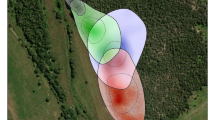Abstract
The behaviors exhibited by first-instarSinea diadema (F.) (Hemiptera: Reduviidae) during intraspecific interactions are described. Five distinct behaviors were characterized: posturing, striking, stalking, stridulating, and beaking. Distinct bouts of grappling were also noted. Interactions between unfed 2-day-old nymphs, unfed 3-day-old nymphs, and unfed 5-day-old nymphs were recorded and analyzed. The behavior of the nymphs changed with the duration of food deprivation. As the period of food deprivation increased from 2 to 5 days, the frequency of posturing decreased as the frequency of beaking increased. During noncannibalistic interactions, posturing or striking by one nymph was most frequently followed by posturing by the other nymph. In contrast, during cannibalistic interactions, posturing or striking was usually followed by beaking. The incidence of grappling increased with the duration of food deprivation. Moreover, grappling always preceded cannibalism. Although first instars were capable of capturing and killing conspecifics of the same age, cannibalism occurred only after 4 days of food deprivation. These results suggest that a decision-making process is involved. During interactions the nymphs can assess the vulnerability of the opponent. Whereas recently emerged nymphs usually forego the risk of attacking conspecifics, the attacks made by nymphs deprived of food are more persistent despite the danger of predation by their opponent.
Similar content being viewed by others
References
Crane, J. (1952). A comparative study of innate defensive behavior in Trinidad mantids.Zoologica 37 259–293.
Croy, M. I., and Hughes, R. N. (1991). Effects of food supply, hunger, danger and competition on choice of foraging location by the fifteen-spined stickleback,Spinachia spinachia L.Anim. Behav. 42 131–139.
Dethier, V. G. (1976).The Hungry Fly, Harvard University Press, Cambridge, MA.
Edmunds, M. (1974). Deimatic behaviour. InDefense in Animals, Longman, New York, pp. 150–153.
Evans, E. W. (1982). Feeding specialization in predatory insects: Hunting and attack behaviour of two stinkbug species (Hemiptera: Pentatomidae).Am. Mid. Nat. 108(1): 96–104.
Fox, L. R. (1975). Cannibalism in natural populations.Annu. Rev. Ecol. Syst. 6 87–106.
Heads, P. A. (1985). The effect of invertebrate and vertebrate predators on the foraging movements ofIshnura elegans larvae (Odonata: Zygoptera).Freshwater Biol. 15 559–571.
Krebs, J. R. (1978). Optimal foraging: decision rules for predators. In Krebs, J. R., and Davies, N. B. (eds.),Behaviourial Ecology: An Evolutionary Approach, Blackwell, Oxford, Melbourne, pp. 23–63.
Marston, N. L., Schmidt, G. T., Biever, D. D., and Dickerson, W. A. (1978). Reaction of five species of soybean caterpillars to attack by the predator,Podisus maculiventris.Environ. Entomol. 7(1): 53–56.
Milinski, M., and Heller, R. (1978). Influence of a predator on the optimal foraging behaviour of sticklebacks (Gasterosteus aculeatus L.).Nature 275 642–644.
Molles, M. C., Jr., and Pietruszka, R. D. (1987). Prey selection by a stonefly: The influence of hunger and prey size.Oecologia 72 473–478.
Morgan, M. J. (1988). The influence of hunger, shoal size and predator presence on foraging in bluntnose minnows.Anim. Behav. 36 1317–1322.
Peckarsky, B. L. (1980). Predator-prey interactions between stoneflies and mayflies: Behaviourial observations.Ecology 61(4): 932–943.
Readio, P. A. (1924). Notes on the life history of a beneficial reduviid,Sinea diadema (Fab.), Heteroptera.J. Econ. Entomol. 17 80–86.
Sih, A. (1980). Optimal behaviour: Can foragers balance two conflicting demands?Science 210 1041–1043.
Sih, A. (1982). Foraging strategies and the avoidance of predation by an aquatic insect,Notonecta hoffmanni.Ecology 63(3): 786–796.
Sokal, R. R., and Rohlf, F. J. (1981).Biometry, 2nd ed., W. H. Freeman, San Francisco.
Stein, R. A., and Magnuson, J. J. (1976). Behaviourial response of crayfish to a fish predator.Ecology 57 751–761.
Taylor, J. R. (1993).Intraspecific Interactions Among First Instar Sinea diadema(F.) (Hemiptera: reduviidae); With Special Reference to Cannibalism, M.Sc. thesis, Department of Environmental Biology, University of Guelph, Guelph, Canada.
Author information
Authors and Affiliations
Rights and permissions
About this article
Cite this article
Taylor, J.R., Schmidt, J.M. Aggression and risk assessment during predatory interactions between first-instarSinea diadema (Fabricius) (Hemiptera: Reduviidae). J Insect Behav 7, 297–311 (1994). https://doi.org/10.1007/BF01989737
Accepted:
Issue Date:
DOI: https://doi.org/10.1007/BF01989737




